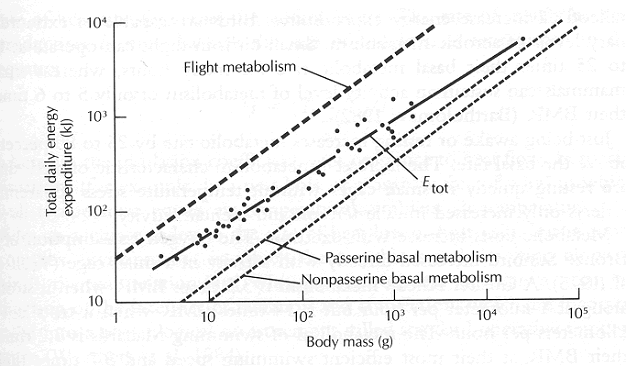

The
Insatiable Appetite – Costs and Benefits of the High Metabolic Rates of Birds
Next lectures will cover a bit of physiology – how do you keep an engine running at such high RPMs? -- and then seque into the annual cycle of birds. Because resources are not available at constant levels throughout the year (daylength changes, winter, dry & wet seasons in the tropics, etc.), and because they have such insatiable appetites, birds have "scheduling conflicts."
“The Primary Directive”:
Reproduce and survive to reproduce again.
Survival requires:
Eat
(and don’t be eaten)
Eating requires:
Being
where there’s food - Migration
Having
feathers - Molting
But first, Metabolic rates:
I.
Physiology
= metabolism & excretion
High body temperature - ca.
40oC (104oF)
maintained by production of
metabolic heat = endothermy
permits use of cold
habitats/climates
provides power and
endurance needed for flight
requires advanced systems
of
heat conservation
heat loss
water economy (evaporative
cooling and excretion)
respiration &
circulation
waste removal (especially N
and CO2)
Specifics -
nerve impulses travel
faster
muscles are stronger
but birds need 20-30 x as
much energy as similar sized reptile
on fine line where proteins
are being denatured
Respiratiory system
components
nostrils (nares) &
nasal chamber (rete mirabile)
trachea (syrinx)
lungs
air sacs (display in
Frigatebirds)
The trick - flow-through
lungs
mammals and herps have
dead-end, always dead air
birds replace virtually all
air in lungs with each breath
air intake by sternum
lower sternum, fill
posterior air sacs
raise sternum, force air
into lungs
Circulatory system
what does it do?
transport O2 and
glucose & fatty acids (fuel)
removes CO2 and
other metabolic waste products
The heart
four-chambered (like
mammals)
reptiles have
3-chambered-but alligators have 4-chambered
oxygenated blood from lungs
goes to right atrium/ventricle
systemic blood from system
goes to left atrium/ventricle to
lungs
50-100% larger than comparable mammals
output
large proportion goes to
legs
more than pectoral muscles!
- heat loss?
legs & brain get 10-20%
of cardiac output
heat loss and conservation
through rete
resting rate 150-300 bpm
lower than some mammals
output higher
heart
larger
stroke
more efficient (ventricle empties more)
Metabolism
High rates
much heat produced
Temperature regulation
TNZ (Thermo-neutral Zone)
ca. 18-35C (64-90F)
LCZ (lower critical zone)
shiver
can’t metabolize brown adipose tissue as mammals do
seek microclimate
evergreens
burrow in snow
cavities (often huddle in
groups)
UCZ - (upper critical zone)
gular flutter
panting - evaporative water loss
controlled hyperthermia
reduces heat loss by decreasing gradient btn body and envirnm. which saves water (less lost in evaporative cooling
II.
Water
Economy
Loss through evaporative
cooling - especially important in arid regions
Brown Towhee evaporative H20
loss quadruples when ambient temp goes from 30 to 40oC
Replaced how?
Drinking
Metabolic water: 6O2 + C6H12O6 -> 6CO2
+6H2O (high
metabolic rate of birds results in more metabolic water than comparable mammals)
food - fruit, prey - Sooty
Falcons nest where temp in shade is 49OC (120oF)
Reduce loss
by countercurrent mech. in
nasal chambers
excrete uric acid instead
of urea
molocule of uric acid has 2xs the N as one of urea insoluble, flushed out
with less H20 - mammals use 20 times
the H20 that birds do to excrete the same amount of N
kidneys different - short
loops of Henle, so excretion of electrolytes (salts) is not as efficient.
salt glands
located above eyes, drain
into nasal passage
widespread in
non-passerines that have salty diets (mostly marine) - examples?
absent in passerines - not
clear why.
enzymatically run
(therefore energetically expensive)
may increase resting metabolism by 7%
Avian Physiology – Continued &
details
Air sacs
9 in most birds (12 in some):
cervical
– 2
thoracic
– 4
abdominal
–2
interclavicular
– 1
extends into bones (humerus & sternum)
contacts syrinx, essential in sound production
heat loss, and cushion internal organs
Furcula – spring-like action helps
with movement of sternum & hence air flow.
Retes – nasal cavities have a “temporal” countercurrent as well as a
vesicular one.
BMR = Basal metabolic rate—yardstick against which cost of activities can be measured.
Resting, in TNZ

(From Gill - Ornithology)
Activity
Metabolism
BMR is rare—almost any activity (slight movements, digestion, etc.)
raises
metabolic rate above BMR
Small birds 10-25 times BMR for hours (mammals only 5-10)
Flight is very expensive, but efficient – compare to mammals
Higher
per unit time, but you go farther per unit time
Varies
with wing shape, flight type—examples?
Egg production, etc.
Insulation
& Heat Loss
H = (Tb – Ta)/I
(Tb
is body temperature, Ta is ambient)
How can a bird manipulate this equation?
Behavior (short & long term) & (longer term) molting
![]()